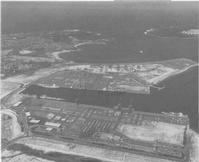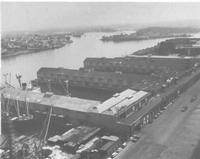


Chapter 6
I Construction During The Settlement Years
II The Use Of Timber As A Structural Material
III Structural Steel
IV Concrete Technology
V Housing
VI Industrialised Pre-cast Concrete Housing
VII Ports And Harbours
i Containerisation
ii Mineral Ports
iii Oil and Gas Ports
iv Other Bulk Cargoes
v Dredging
VIII Roads
IX Heavy Foundations
X Bridges
XI Sewerage
XII Water Engineering
XIII Railways
XIV Major Buildings
XV Airports
XVI Thermal Power Stations
XVII Materials Handling
XVIII Oil Industry
XIX The Snowy Mountains Scheme
XX The Sydney Opera House
XXI The Sydney Harbour Bridge
XXII Hamersley Iron
XXIII North West Shelf
Sources and References
Index
Search
Help
Contact us

Containerisation
The maximum exchange of a general cargo ship pre-containerisation at a capital city port was approximately 7,000 tonnes, whereas with present container ships it can be as high as 20,000 tonnes. It is mainly for this reason that land areas in the order of 14-15 ha per berth are now needed for container terminals, whereas previously a general cargo berth would have had a maximum of 4-5 ha.A typical example of modern world-class container facilities is shown in Fig. 17 of Port Botany and these can be compared with Fig. 18 showing shipping facilities existing at Darling Harbour, Sydney, until the early 1960s. Port Botany container berths meet the unique requirements of the container trades, in that each terminal has approximately 1,000 metres of wharfage, capable of accommodating at least three present day container ships, three 35 tonne wharf cranes, 15.25 metres of water at the face of the berths, 42 ha of 'backup' land, paved to meet the 100 tonne axle loadings imposed by mobile container handling equipment, and major road and rail links. Fig. 17 also shows the 2 km armoured revetment wall constructed to protect the reclamation and create a still water port in the area of Botany Bay originally most exposed to wave attack. The design of this port to ensure that container ships can be loaded and unloaded regardless of offshore wave heights of 10 metres would not have been practical without current mathematical and physical modelling techniques.


Specialised container terminals have been provided at Sydney, Melbourne, Adelaide, Fremantle, Brisbane, Darwin and Geelong. In addition, container cranes are also available at Townsville, Newcastle and Burnie.
People in Bright Sparcs - Wallace, J. M.
 |
Australian Academy of Technological Sciences and Engineering |  |
© 1988 Print Edition pages 339 - 340, Online Edition 2000
Published by Australian Science and Technology Heritage Centre, using the Web Academic Resource Publisher
http://www.austehc.unimelb.edu.au/tia/341.html